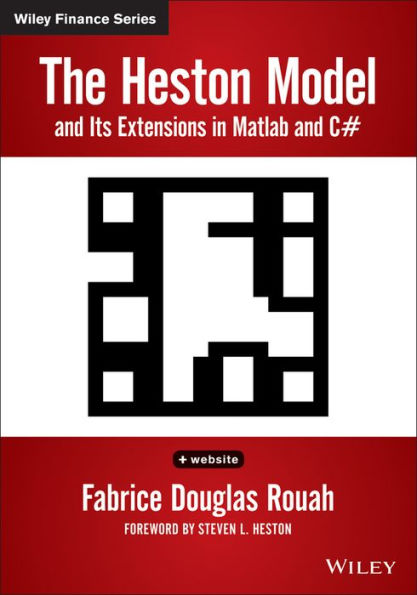
The Heston Model and its Extensions in Matlab and C#
432
The Heston Model and its Extensions in Matlab and C#
432Overview
Praise for The Heston Model and Its Extensions in Matlab and C#
"In his excellent new book, Fabrice Rouah provides a careful presentation of all aspects of the Heston model, with a strong emphasis on getting the model up and running in practice. This highly practical and useful book is recommended for anyone working with stochastic volatility models."
—Leif B. G. Andersen, Bank of America Merrill Lynch
"Without a doubt, Fabrice provides a very valuable contribution to quantitative analysts interested in pricing options with state-of-the art techniques."
—Marco Avellaneda, New York University
"The Heston model is one of the great success stories of academic finance. Rouah's impressive book provides users with all the tools required to implement the Heston model, and wonderfully bridges the gap between academia and practice."
—Peter Christoffersen, University of Toronto
"In this encyclopedic work, the author takes delight in exploring every aspect of the Heston model. Together with its included Matlab and C# code, this book will prove invaluable to anyone interested in option pricing. I highly recommend it."
—Jim Gatheral, Baruch College author of The Volatility Surface: A Practitioner's Guide
"This is the most extensive work on the Heston model I have seen: derivations, implementations, and discussions. For anyone interested in the Heston model and its variations, this is an important book to have!"
—Espen Gaarder Haug, Norwegian University of Life Sciences author of Derivatives Models on Models
"Rouah offers a unique and much needed synthesis of the literature regarding Heston's model of stochastic volatility. The author has accomplished the formidable task of presenting a large body of published academic and industrial research in a coherent, thorough, and very reader-friendly manner."
—Andrew Lesniewski, DTCC
"Beyond Black-Scholes, the Heston model is arguably the most important model in quantitative finance and certainly deserves its own book. Rouah provides here a comprehensive treatment—clearly discussing all the major issues, later extensions, and subtle traps."
—Alan L. Lewis, PhD, author of Option Valuation Under Stochastic Volatility: With Mathematica Code

Product Details
| ISBN-13: | 9781118695173 |
|---|---|
| Publisher: | Wiley |
| Publication date: | 08/01/2013 |
| Series: | Wiley Finance |
| Sold by: | JOHN WILEY & SONS |
| Format: | eBook |
| Pages: | 432 |
| File size: | 21 MB |
| Note: | This product may take a few minutes to download. |
About the Author
Table of Contents
Foreword ixPreface xi
Acknowledgments xiii
CHAPTER 1 The Heston Model for European Options 1
Model Dynamics 1
The European Call Price 4
The Heston PDE 5
Obtaining the Heston Characteristic Functions 10
Solving the Heston Riccati Equation 12
Dividend Yield and the Put Price 17
Consolidating the Integrals 18
Black-Scholes as a Special Case 19
Summary of the Call Price 22
Conclusion 23
CHAPTER 2 Integration Issues, Parameter Effects, and Variance Modeling 25
Remarks on the Characteristic Functions 25
Problems With the Integrand 29
The Little Heston Trap 31
Effect of the Heston Parameters 34
Variance Modeling in the Heston Model 43
Moment Explosions 56
Bounds on Implied Volatility Slope 57
Conclusion 61
CHAPTER 3 Derivations Using the Fourier Transform 63
The Fourier Transform 63
Recovery of Probabilities With Gil-Pelaez Fourier Inversion 65
Derivation of Gatheral (2006) 67
Attari (2004) Representation 69
Carr and Madan (1999) Representation 73
Bounds on the Carr-Madan Damping Factor and Optimal Value 76
The Carr-Madan Representation for Puts 82
The Representation for OTM Options 84
Conclusion 89
CHAPTER 4 The Fundamental Transform for Pricing Options 91
The Payoff Transform 91
The Fundamental Transform and the Option Price 92
The Fundamental Transform for the Heston Model 95
Option Prices Using Parseval’s Identity 100
Volatility of Volatility Series Expansion 108
Conclusion 113
CHAPTER 5 Numerical Integration Schemes 115
The Integrand in Numerical Integration 116
Newton-Cotes Formulas 116
Gaussian Quadrature 121
Integration Limits and Kahl and J ¨ ackel Transformation 130
Illustration of Numerical Integration 136
Fast Fourier Transform 137
Fractional Fast Fourier Transform 141
Conclusion 145
CHAPTER 6 Parameter Estimation 147
Estimation Using Loss Functions 147
Speeding up the Estimation 158
Differential Evolution 162
Maximum Likelihood Estimation 166
Risk-Neutral Density and Arbitrage-Free Volatility Surface 170
Conclusion 175
CHAPTER 7 Simulation in the Heston Model 177
General Setup 177
Euler Scheme 179
Milstein Scheme 181
Milstein Scheme for the Heston Model 183
Implicit Milstein Scheme 185
Transformed Volatility Scheme 188
Balanced, Pathwise, and IJK Schemes 191
Quadratic-Exponential Scheme 193
Alfonsi Scheme for the Variance 198
Moment Matching Scheme 201
Conclusion 202
CHAPTER 8 American Options 205
Least-Squares Monte Carlo 205
The Explicit Method 213
Beliaeva-Nawalkha Bivariate Tree 217
Medvedev-Scaillet Expansion 228
Chiarella and Ziogas American Call 253
Conclusion 261
CHAPTER 9 Time-Dependent Heston Models 263
Generalization of the Riccati Equation 263
Bivariate Characteristic Function 264
Linking the Bivariate CF and the General Riccati Equation 269
Mikhailov and No¨ gel Model 271
Elices Model 278
Benhamou-Miri-Gobet Model 285
Black-Scholes Derivatives 299
Conclusion 300
CHAPTER 10 Methods for Finite Differences 301
The PDE in Terms of an Operator 301
Building Grids 302
Finite Difference Approximation of Derivatives 303
The Weighted Method 306
Boundary Conditions for the PDE 315
Explicit Scheme 316
ADI Schemes 321
Conclusion 325
CHAPTER 11 The Heston Greeks 327
Analytic Expressions for European Greeks 327
Finite Differences for the Greeks 332
Numerical Implementation of the Greeks 333
Greeks Under the Attari and Carr-Madan Formulations 339
Greeks Under the Lewis Formulations 343
Greeks Using the FFT and FRFT 345
American Greeks Using Simulation 346
American Greeks Using the Explicit Method 349
American Greeks from Medvedev and Scaillet 352
Conclusion 354
CHAPTER 12 The Double Heston Model 357
Multi-Dimensional Feynman-KAC Theorem 357
Double Heston Call Price 358
Double Heston Greeks 363
Parameter Estimation 368
Simulation in the Double Heston Model 373
American Options in the Double Heston Model 380
Conclusion 382
Bibliography 383
About the Website 391
Index 397
